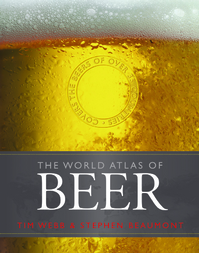Authors pay homage to both Michael Jackson and the new world of craft beer
Added: Friday, September 7th 2012
The World Atlas of Beer
Tim Webb and Stephen Beaumont, Mitchell Beazley, £25.
In 1977, just as I was getting my feet under the bar stool as a beer writer, a large tome dropped on my desk called the World Guide to Beer. It was written, with great elegance and quiet passion, by Michael Jackson. The scales dropped from my eyes. I learnt, I as raced and marvelled through the pages, that there was far more to beer than British mild and bitter. There was, to my great astonishment, good beer hiding beneath the fizz in the United States. The French (the French?) produced fascinating beer styles and there was more to Foster’s and XXXX Down Under. And then there was Belgium...

It was the book that made Jackson’s reputation and all later works that purport to be guides to world beer – mine included – are measured by his seminal work and most come up wanting. Webb and Beaumont have an added problem: their book is published by the same house that launched the World Guide to Beer and they run the risk of being judged alongside their mentor.
As I read the new book, I realised what a remarkable achievement Jackson’s guide had been. No internet, no Google, little source material. Large swathes of central and eastern Europe were behind the Iron Curtain where requests for information, let alone visits, were treated with stony-faced suspicion. (I’ve been trying this year to get a response to requests for information about Cuban beer and find that old habits die hard.)

Webb (Left) and Beaumont (below) not only pay tribute to Jackson but also admit their task has been made easier by the fund of information that now exists about beer. They also say at the outset that while beer was struggling to survive in the 1970s today it’s enjoying a remarkable renaissance. This is despite the efforts of global brewers to eradicate taste and flavour from brews the authors neatly describe as “convenience beers”.
They attempt the Herculean labour of both walking in Jackson’s giant footsteps and widening the horizons of world beer. Their unenviable task is what to leave out at a time when new beers, new breweries and new styles arrive daily, like mushrooms at dawn. Just when you think it’s safe to finish a book, Americans start to brew sour ales, everyone and his brother is suddenly ageing beer in wood and some brewers have the audacity to produce something called Black IPA.
The new book follows Jackson’s guide by dividing the world into convenient regions: Europe, the Americas, Australasia and so on. It departs from the original by being shorter on words and longer on maps and images. It is, after all, an atlas and the maps are excellent, not only detailing the positions of breweries but in some cases stating their dates of origin. The images, on the other hand, range from the brilliant to the annoying: given the price of the book, do we need a number of double page spreads showing beaches, mountains, prairies and, in one, case a vast rack of around 60 bottle ends. If you’ve seen one bottle end, you’ve witnessed all you need.
The brevity of some sections begs the question: who is the book aimed at? It’s a problem all beer writers face. Is the book for newcomers to the subject, people with a passing acquaintance, or for experts in the field? It’s all too easy to fall between the groups and the atlas successfully, I feel, reaches out to the middle section comprised of people moving from convenience beer to those with taste and character. Like the young man standing next to me in the beer section of my local Budgens last year who asked me (I kid you not), “Do you know anything about beer?” and added: “I’m just getting interested in ale but don’t know what to try.” I sent him home, I hope happily, with Young’s Special London Ale and Marston’s Old Empire but he declined to sample Hobgoblin on the grounds that “I’m not really into dark beer yet.” The atlas may help him discover the joys of porter, stout and black lager but, not I trust, Black IPA.

The brevity of some sections is frustrating. When you consider Tim Webb’s bounteous knowledge of all things Belgian, the short essay on lambic and gueuze – arguably the most fascinating of all beer styles – is disappointing. A few other grumbles: a section that bundles together Great Britain and Ireland is insensitive both politically and from a beer point of view. Both countries may inhabit the British Isles but the traditions and the styles of beer are different, and the Irish did have a long struggle for independence from their neighbour. The shortness of the section on Australia and New Zealand, where dramatic things are happening, suggests the authors were running out of steam, deadlines and air miles by the time they looked Down Under. The few pages devoted to matching beer and food underline my belief that you either tackle this subject head on and full bore or not at all.
But the good far outweighs the lapses. The section on the U.S. and Canada is splendid, due mainly to the input of Toronto-based Stephen Beaumont. Each section and its styles is illustrated with chosen beers and tasting notes. If my brief acquaintance in Budgens buys the book he will learn not to be afraid of the dark and may move on to retail outlets with wider choice that will introduce him to the diversity of world styles now available.
One disappointment with the book is that it’s written in a somewhat flat and passionless style. Those of us who love Tim Webb’s Good Beer Guide to Belgium know he’s a writer of enormous verve and with an excoriating wit. He seems to have had his sting removed by Mitchell Beazley but that may be the result of two authors with strong opinions as well as writing styles working in tandem.
But, minor caveats aside, this is a handsome guide that nobly picks up the flame Michael Jackson laid down in 2008. It takes us on a dizzying but delightful journey of the beer world. It rightly ignores the bland and lacklustre offerings of the merchants of fizz and pays due homage and tribute to the craftsmen and women who have restored the good name of the world’s favourite beverage.









